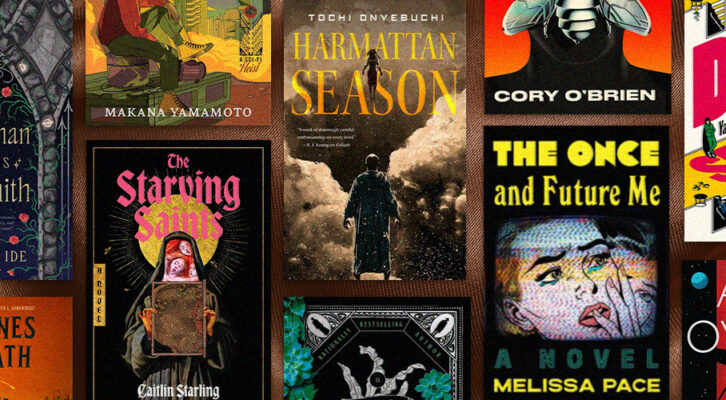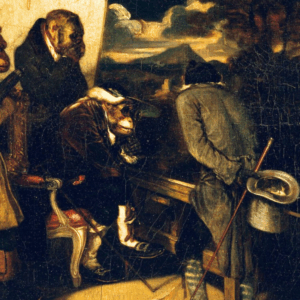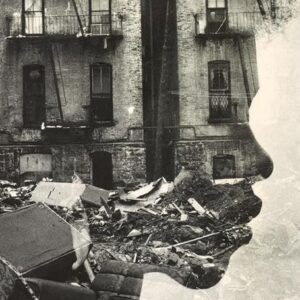
When Your New York Apartment Has a Secret Literary Past
On Finding Yourself in a Real Life Jonathan Lethem Novel,
Above a Hidden Bookstore
It was about three years ago now that my boyfriend and I met the broker of our current apartment. On that December morning, we walked down 84th Street, scanning the building numbers until we found our destination. I felt mildly disappointed as the broker brought us inside the old walk-up building. There was no charming stoop or elegant façade, nothing to distinguish it from the outside. The building itself seemed to recede behind the commercial enterprises on the ground floor: barbershop, dry cleaner, piano bar. This is a building where one glances up to the higher floors and thinks: oh, right, people actually live here.
I should have been used to the sensation by that point. Perhaps because New York has so little space to go around, there is a fierce delineation between the public and private. I’d visit a friend’s apartment for the first time and be depressed by the building’s exterior, the hallways with bad lighting and flaking paint and shabby floors, wondering what it was like to call this place a home. But it always changed when the apartment door itself swung open. The lighting was warm, something in the kitchen smelled good. A separate world was revealed, one created with love and attention, a life carefully built within an indifferent structure.
That morning three years ago, the broker led us up three flights of stairs and opened the door. The apartment was undergoing renovation, but right away we could see the potential. It was bigger than our current place, and it got better light. The kitchen would be brand-new. The rent was reasonable. It was an easy decision.
Before we signed the paperwork and sent in our deposit, we did the requisite Googling—having learned the hard way—to make sure there was no history of bed bugs at that address. The report came back clean, but there was also the question of the piano bar on the first floor of the building. The broker and the super and the landlord had assured us it would be fine. We searched the name of the bar, plus “noise complaint,” and sure enough, there were no results from 311 or other agencies. But the search did return an odd result: an excerpt from the novel Chronic City by Jonathan Lethem.
I had read and loved the novel a few years prior, when it was published in 2009. The excerpt that Google surfaced came from the beginning of the book. It introduces one of the main characters, Perkus Tooth, and describes his apartment building—which was, in fact, our apartment building:
His apartment was on East 84th Street, six blocks from mine, in one of those anonymous warrens tucked behind innocuous storefronts, buildings without lobbies, let alone doormen. The shop downstairs, Brandy’s Piano Bar, was a corny-looking nightspot I could have passed a thousand times without once noticing. BRANDY’S CUSTOMERS, PLEASE RESPECT OUR NEIGHBORS! pleaded a small sign at the doorway, suggesting a whole tale of complaint calls to the police about noise and fumes. To live in Manhattan is to be persistently amazed at the worlds squirreled inside one another, the chaotic intricacy with which realms interleave, like those lines of television cable and fresh water and steam heat and outgoing sewage and telephone wire and whatever else which cohabit in the same intestinal holes that pavement-demolishing workmen periodically wrench open to the daylight and to our passing, disturbed glances. We only pretend to live on something as orderly as a grid. Waiting for Perkus Tooth’s door buzzer to sound and finding my way inside, I felt my interior map expand to allow for the reality of this place, the corridor floor’s lumpy checkerboard mosaic, the cloying citrus of the superintendent’s disinfectant oil, the bank of dented brass mailboxes, and the keening of a dog from behind an upstairs door, alerted to the buzzer and my scuffling bootheels.
I felt a delighted sense of recognition: the lemony smell of the newly mopped floors, the banged-up mailboxes. Those were about to become my floors, my mailboxes. What were the odds of this? The odds that this writer had decided to house his character in this completely unremarkable building, out of all the addresses available to him in New York City? I had thought we were moving somewhere new only to discover that I had, in fact, spent many hours there already. This confirmed it—we were meant to live here! I had read Chronic City while I was still in college, but now that I lived in New York, I appreciated anew the accuracy of that line: “To live in Manhattan is to be persistently amazed at the worlds squirreled inside one another.” It captured that feeling of visiting a friend’s apartment for the first time: finding it so much more particular, so much more specific than anything you could have imagined.
I told my friends about this weird coincidence. Those who had read the book found it interesting, but I stopped telling the story before long. I didn’t really know what to make of it. It was probably just that: a coincidence. The author had probably walked past this building one day and deemed it good enough. In any case, what we had taken to be a positive omen quickly dissolved in the face of bigger challenges.
I’m not naïve. I know there is no such thing as the perfect apartment in New York. Even if you think you’ve found it, on your first night or third night or tenth night, you will realize that something is wrong. A chain-smoking neighbor, a refrigerator that makes strange noises, a sticky window, a missing-in-action super, a persistent mouse. In a place this crowded and dense, there will always be someone else bumping up against you. But some problems are bigger than others. The trick is figuring out which flaws are worth living with and which will drive you to a breaking point.
In the new apartment on 84th Street, we feared we were getting close to that point. The piano bar on the first floor: of course we could hear the music. How willfully optimistic to think otherwise. That first night in the apartment, our mattress still on the floor, we lay wide awake until 3 in the morning, the strains of “Piano Man” and “Tiny Dancer” echoing up through the walls. It was unbelievably loud, like the band was in our living room. “It can’t be like this every night, right?” we asked ourselves. (Maybe I am naïve.) But good old Brandy’s Piano Bar had been open since 1979, every day of the year except Christmas, and it wasn’t going anywhere. There was no question it would outlast us. So we coped, the way everyone in Manhattan does. We bought white noise machines and fans and ear plugs. We adapted.
I know there is no such thing as the perfect apartment in New York. Even if you think you’ve found it, on your first night or third night or tenth night, you will realize that something is wrong.
Our uncertainty about the apartment lasted for several months. We figured we’d stay for the year, and then move. But one day, we realized that we were doing okay. In fact, we were happy there. It was, after a period of adjustment, the right fit. We’d been right to grit our teeth through those loud nights. Our relationship to this apartment felt like a mature one, one that required us to ask ourselves what we really valued. Eventually, we stopped hearing the music altogether.
After several months in the new apartment, I ran into a friend of mine. She remarked that she’d been coming to our building a lot lately—but not to visit us. Instead, she was there for the secret bookstore on the second floor.
The what?! I asked.
She explained. It was an unlisted address, a word-of-mouth operation. The occupant of the apartment was a bookseller, who, after losing the space for his previous bookstore, had started selling books out of the apartment. It wasn’t remotely legal, running a retail business out of a residence, so he kept it quiet. People found out from friends, or contacted the bookseller through his website, and pressed an unmarked buzzer to get in. It was usually open on Thursdays and Saturdays, and sometimes for poetry readings on Tuesdays.
It is amazing what the mind can explain away, the fuzzy logic that fills a vacuum. I had noticed the comings and goings from this apartment, the clusters of people on the second floor. I assumed whoever lived there was particularly social. Someone who had a lot of dinner parties and cocktail parties. I never thought there was anything unusual about it.
I tagged along the next time my friend went, descending two flights of stairs from my apartment, the stairs I trudged up and down every single day. What followed was like magic, like something out of a children’s book, or a dream: discovering the false back to the wardrobe, the room you forgot existed. The apartment door opened into a narrow hallway, which led to a warren of rooms. The floor was creaky and uneven, and covered in old carpets. Jazz played on the stereo, and a small air conditioner hummed in the window. There were books everywhere: stacked in teetering piles on tables, shelved two deep. There were sections of poetry, biography, pulpy paperbacks, oversized art books, rare first editions tucked into a side room. On a table near the entrance, there was a bottle of whiskey on offer, a stack of cups and a bucket of ice.
I was enchanted. This was a version of heaven, two floors below my apartment. There is a romantic notion of the independent bookseller, one that most publishing people are prone to, even as we know how hard it is, how slim the margins, how high the rents. But still, a bookstore is a lighthouse: the guide through bad weather, the welcoming glow at the end of a long journey. A bookstore is the place where a book is opened and, therefore, where it is born. It is often the best part of the neighborhood. And here I had found one within my own building.
I got to chatting with Michael, the owner of the bookstore. The alliance felt easy, because we had mutual things to gripe about: the music from Brandy’s, our strange neighbors. My happiness at discovering the bookstore was intensified by the chance way I’d wound up here. What if I hadn’t run into my friend, or what if she hadn’t mentioned it? But I was here. This strange building kept yielding surprises. I started to explain the first surprise to Michael, the Chronic City connection, how funny that coincidence of addresses was. The conversation must have gone something like this:
Me: “And, so, isn’t that a weird coincidence?”
Him: “No. Jonathan based it on the apartment right next door.”
Me: “What?”
Him: “My dog was the dog in the book.”
Me: “What?!”
There is a longer version of this story, but the short version is that it wasn’t a coincidence at all. Jonathan Lethem was an old and dear friend of Michael’s. When he was younger, he’d worked in one of Michael’s bookstores. He’d spent many days here, in this building. It wasn’t just an address plucked from the grid. The fictional scrim that I’d imagined floating above our real lives was, in fact, tethered to reality by sturdy ropes.
The world of the novel had sprung from this very place: the floor I was standing on, the air I was breathing. Michael showed me a picture of his dog, the inspiration for the fictional dog Ava, and told me about his friend, the inspiration for the fictional character Biller. He showed me the kitchen of the apartment next door, which was the model for Perkus Tooth’s apartment in the book, down to the airshaft window and linoleum floor. I had already explained the coincidence to myself, had tucked it away in a corner of my mind, the same way I explained the bustle of the second-floor apartment by imagining constant dinner parties. What else had I failed to imagine? I climbed the stairs home that night, delighted that the wardrobe really did lead to Narnia.
A few weeks later, Jonathan Lethem was in town for a book festival. He dropped by the bookstore that Saturday night. Michael introduced me to him, and I was at last able to close the loop. I told him how much I loved the book, how uncanny it was to share an address with a beloved fictional character. He was perfectly kind and gracious about it. But, for me, there was something eerie about the experience. He was the writer, the creator, the sturdiest connection between fiction and reality. The coincidence, in the end, wasn’t the presence of a fictional character in my building. It was the presence of the writer who had created the character. What had charmed me initially hadn’t disappeared, but it had shifted.
I knew this would make a good story one day. It’s a weird one, even by New York standards. And now I had my ending, didn’t I? But what bothered me was that I didn’t know how to tell it—what the point of it was. Maybe it’s about the mysteries of the city, the facades that conceal worlds behind them, the dolls that we don’t realize are matroyshka dolls. Maybe it’s a story about trade-offs and unlikely compensations. If we hadn’t stuck through the agony of Brandy’s, we never would have discovered the bookstore. Maybe it’s a story about hope, that even when gentrification defines the era, when Dorothy Parker and Max Perkins and the grand bookstores on Fifth Avenue are a vanished dream, there is still a small rebuttal to be found.
But I suspect the story may be simpler than that. I visited the bookstore for the first time in September 2014, and by July 2015 it had closed. The eviction notice wasn’t a surprise; Michael had been expecting it for years. If anyone in the building was unaware of the bookstore, those final weeks would have been the tip-off. Our address became the site of a literary pilgrimage. People flooded in for a long wave of goodbyes. There were articles and tributes to Michael and the bookstore. The secret had been mine for only a few months.
And then one night, returning home, I found a crew of skinny young men and women on the sidewalk, sweating in the hot summer night and smoking cigarettes as they took a break from moving duties. When I passed the second floor, outside Michael’s door, there were boxes and furniture waiting to be carted downstairs. It was like that for a few days, and then it was quiet. No more visitors, no more boxes, no more bookstore. Just another empty apartment that will soon be gutted and renovated and home to tenants willing to pay a higher price, tenants who might be aware of what came before them, but who might not. In the end, it may be the most ordinary story—one about change.
In thinking about this story, I find myself thinking about density, and how that affects a person’s relationship to a place. When the buildings are higher and apartments are smaller, when lives stack atop one another like Lego blocks, it increases a person’s exposure to change. I remember the diagram my science teacher used to illustrate the difference between solid and liquid and gas states. In a gas state, there are fewer molecules, and they are free to zoom around, oblivious of their neighbors. But in a solid state, there are more molecules, and they are packed tightly together. I imagine each of those molecules as a person within the solid state that is New York City. With a tiny radius there is more life, more turnover, more change.
Before we lived on 84th Street, we lived on 77th Street. It’s a difference of seven blocks, half a mile, a ten-minute walk. And yet, for the dislocation I felt, we might as well have moved across the state. Every part of our daily routine changed in that short move. We had a new subway stop, a new drycleaner, a new drugstore, a new coffee shop, a new grocery store, a new parade of faces. There were people whom I’d seen on a daily basis for years, but one day I moved seven blocks north, and I never saw them again.
This, I know, is a common occurrence for New Yorkers. It’s one of those convoluted feelings for which there ought to be a German word: homesickness for a place that is within spitting distance. It’s only possible in a place of density, like New York. In a place where the options are limited, like a small town, one’s routine is resilient. You move half a mile away, and you keep going to the same grocery store, because there aren’t a dozen other grocery stores between your old house and your new house. It seems silly, and seven blocks seems like nothing, until you stop to consider how much life is packed within those blocks.
When I occasionally walk down 77th Street, past our old apartment, that convoluted feeling returns to me. Part of it is nostalgia, remembering everything that happened there. Part of it is regret for not appreciating it more: our scrabbly but wonderful backyard, the quiet street, the diner on the corner. Part of it is curiosity: does the nice guy still work at the drycleaner? Is that three-legged corgi still around? But most of it is a keen sense of time passing. The truth is that we could probably move back to that street, maybe even back to our building. But we wouldn’t do that, because the place isn’t exactly what I miss.
It’s one of those convoluted feelings for which there ought to be a German word: homesickness for a place that is within spitting distance.
The longing flows in one direction. Don’t you miss me? I think in a moment of indulgence, but of course my absence goes unnoticed. I was surprised, though I shouldn’t have been, by how strange it was to return to my college campus for the first time after graduation. There was no evidence of my ever having been there. The bed I’d slept in mere months ago was now occupied by someone who didn’t know my name. This happens even faster in a city like New York. Returning to an old and familiar place brings the memories rushing back—memories impossibly vivid and as specific as fingerprints: the hot chocolate with whipped cream at the diner, the soapy smell of the iron at the dry cleaner, the Godfather soundtrack playing in the Italian grocery store on Sunday afternoon—but they are still just memories. I am keenly aware that when I am thinking about those things, I am also thinking about a former version of myself experiencing those things.
In some places, perhaps you can trick yourself into thinking that certain things will endure. The quaint sleepiness of a small town, a farm passed down through generations: if these things are lost, they come like a blow. Perhaps it is tempting to see the loss as preventable, as avoidable. But in New York, there is nothing to be done. One learns this very quickly. That apartment can’t remain empty; someone else has to move into it. The city doesn’t have room to let monuments remain monuments. When I walk to work in the morning through Central Park, every bench I pass is dedicated to a husband or a wife or a loved one, but often the plaques aren’t visible because someone else is sitting in front of them, a person alive and busy and ignorant of the dedication. I think of this, sometimes, when I walk past where we used to live. There are layers of the city that are visible only to an audience of one. Except to the very few, a bench erected in memory of a loved one is still just a bench.
I think that the best cure for writer’s block is to take a walk, to let one’s awareness sharpen itself against the world like a knife against a stone; to remember how the sunlight changes in the afternoon, or how imprecisely people talk, or how noise echoes through the street. My daily walk to work through Central Park does this: I find myself noticing new things, little things, no matter how many times I trace the same route. My awareness of the changing seasons has sharpened; not just the change, but the way the city absorbs the change. The trees along the Mall are my barometer. There was the day in March when green buds started to appear along the branches, despite the thin dusting of snow on the ground. Then there was the day in October when the trees dropped their colorful leaves all at once, like a grand bow at the end of a show. It was a lovely sight in the morning, the Mall carpeted with crunchy leaves, but by the time I walked home that night, the ground was covered in a thin orange paste, the leaves trampled and transformed by thousands of feet. They were no longer recognizable. I thought about the leaves I’d seen in the woods of rural New England, and how they would remain essentially undisturbed for months. The winter would cover them in rain and snow, but come spring they would be revealed again. With quiet and stillness and open space, something can remain itself for a long time. But in New York City, even in just a few hours, a thing can become something else entirely.
This, I think, is part of the romance. It’s why writers will always write books about New York, and readers will always read them. The city is never static, not even for one day. There is heartbreak in this: old businesses pushed out by rent hikes, neighborhoods transformed by gentrification. But there can be consolation, too, to living in a city where density can conceal so much. There is what seems obvious about New York—the brash, ambitious city I thought I was moving to—but that is only the thinnest layer of ice atop a very deep lake. The city is changing constantly, and that change provides an opening.
We still live in the same building. It’s the apartment in which I have felt like a grown-up for the first time; the apartment in which I’ve begun to think, maybe we could actually live in this city forever. It’s the apartment in which I finished my first book—a book about, yes, New York. I think of how plain our building looks from the outside, how easy it is to miss the front door, sandwiched between Brandy’s and the drycleaners. And then I think of the bookstore, hidden in an apartment on the second floor, and of Chronic City, the novel that sprung from this ordinary-looking place. I think of how much I still don’t know about my neighbors. In my earliest days of living here, the city seemed to repel newcomers like me, and I heard that I was too late: I had missed the old New York, the real New York. But I think of how much I still walk by without noticing, and I keep my eyes open, knowing that the magic remains hidden unless you know where to look.
Anna Pitoniak
Anna Pitoniak is an editor of fiction and nonfiction at Random House. She graduated from Yale in 2010, where she majored in English and was an editor at the Yale Daily News. She grew up in British Columbia.



















